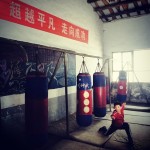I sent for “The Shaolin Monastery” and “Thrown” a couple of weeks ago and have already made it to the end of the former. I wrote a small essay for Fightland that basically elaborates slightly on the first few chapters of Meir Shahar’s work on the Shaolin Monastery, and I might squeeze out another article on the transition from staff to fist. I found that to be pretty interesting, the fact that the staff came from the lore of proto-Buddhism, became the weapon of choice for the fighting monk, but then sometime around the Ming dynasty gave way to fists and hand to hand combat techniques.
It shouldn’t be surprising really. From the Yuan to the Qing there is a “civilizing” wave that swept through China (and the world?) that transformed the hard, short, and brutal lives of medieval people into the stratified, maybe even fulfilling lives of the pre-modern eras. The literary record changes, the types of writings we see change, and the topics people wrote of changed. Did the Mongols have anything to do with it? Or was it just a continuance of the Song dynasty’s regal splendor, broken up for a century by interlopers? I don’t know … just musing.
Also Meir Shahar needs to be commended for pulling so much out of the Chinese sources he has. I read through some of them and it requires a incredible amount of cross referencing and lateral studies to understand what exactly is being discussed. The Chinese seem to enjoy vagaries when being scholarly. It’s as if the old historians can’t suppress those original dreams of being a wandering poet-warrior-minstrel. Instead, they record the wanderings and exploits of others and add as much poetry as they can. I guess any classical/medieval/pre-modern writing will seem so old to young eyes. I for one find classical Greek descriptions of minor king and Song era musings on temples and peaks and the clouds to be absolutely entrancing.
I have looked into the classical curriculum here at the University of Minnesota.
********
As for Thrown, it hits much closer to home. Kerry Howley shadowed two fighters while she was at the University of Iowa’s famed Creative Writing program, and pretty much dropped the mic on the MMA story for now. It was never my intention to write a book like Kerry’s, in the sense of following around MMA fighters and recording their actions while placing them into a heady phenomenological framework, but then again it kinds was, except I trade Iowa for Sichuan and MMA for kung fu.
It will be hard at first, to read something written as I feel I might be able to write, but then again it reminds me of stretching. It hurts at first, but as soon as you get into the right breathing sequence, it’s positively divine. I expect to learn so much from her book, be inspired by her findings, and be able to find new and interesting nooks in my own experience and readings as I flip through hers.
I do not, however, expect people to muse out loud about whether or not I slept with my subjects.




